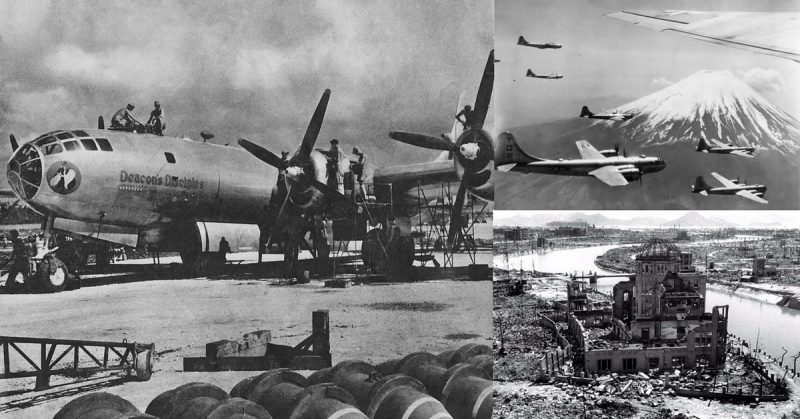In this DAKOTA HUNTER Blog, you will see photos of the USAAF Boeing B-29 Superfortress Fleet departing from theMarianas Islands for the Bombing of Japan that started on the 1st of November 1944. The
The Air force bases on the tiny islands of Saipan, Tinian, and Guam brought for the first time in the war Tokyo within flight range of the mighty B-29.
Both the Normandy Invasion in Europe and the invasion of the Marianas Islands (both taking place by mid-1944 on 6 June and 15 June resp.) were the beginning of the end for the Third Reich and for The Empire of the Sun, be it that the Pacific War took more than 3 months longer which caused a terrible extra loss of soldiers and civilians.
Photo below: After the US Military Forces invaded the Mariana Islands in the summer of 1944, they paid for that with thousands of lives. The USA could not be paid back for those dead soldiers, sailors, and marines, but they have used well what they fought to get. Every day, B-29s were roaring out of the 5 airfields on the 3 major islands of the Marianas. Guam, Saipan, and Tinian were the islands from where the USA started to bomb the home islands of Japan.
Every day thousands of tons of cargo were unloaded in newly dredged harbors. Guam, largest of the Islands had been turned into an advance HQ for the Navy, it was soon the nerve and supply center of the Pacific War.
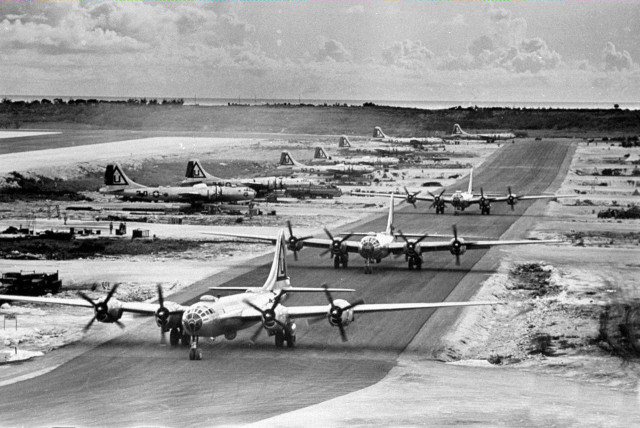
The quickly expanded or newly constructed airfields on the 3 islands took the role of 5 XXL-sized “aircraft” carriers for the huge Bomber Fleet. Each one of that Air Force bases could house max. 180 B-29’s. More advanced in position toward the Enemy Capital than the allied South Chinese Airfields near Kunming, from where also bombing flights took place with the B-29. But the supply of fuel and bombs from India to those Chinese fields was a logistics nightmare as there was no road, all materials had to be flown in over the Hump and sensitive for attacks. In contrast, the Marianas with direct shipping lines from Hawaii and USA were the perfect location for massive attacks on Nippon. Since Doolittle´s epic assault on Tokyo in April 1942 from the Aircraft carrier USS Hornet with only 16 B-25 Mitchells, there was now finally a follow-up . On 24 November 1944, 2,5 years later, they came back. Big Time, with 111 B-29s eclipsing the skies over Tokyo. And that was only the start of worse to come.
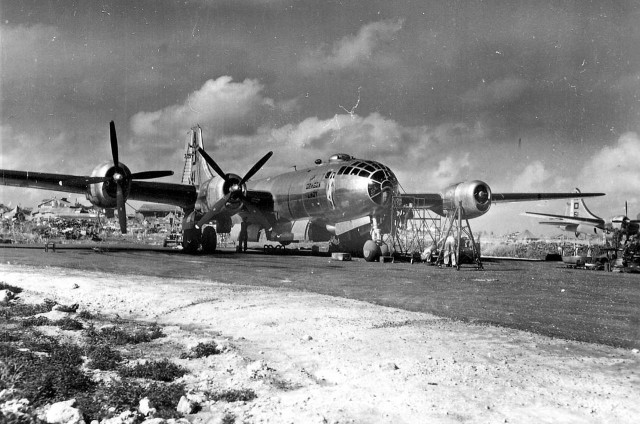
Photo above, a superbly sharp shot depicting the maintenance of a B-29 with scaffolds and tripod hoist set up for a prop or an engine exchange.
The loss of the Marianas had far-reaching consequences for Japan. Even in the Japanese Army and Government, there were many Top ranking officers, that later admitted that once they heard that Saipan had fallen, the Day of Doom for The Evil Empire was only a matter of a final countdown over the months to come. That fall was also the political end of one of the greatest warmongers of Japan, General Tojo. Since 1941, he was Prime Minister, Minister of Foreign affairs and Minister of War and by many considered as the true “Dictator of Japan” with absolute power. However, in a surprise move in July 1944, as final responsible for the many Military defeats, he had to step down as a Prime Minister. That reflected the emotional tsunami that hit the Japanese Nation and Government in its Solidarity stance with its Military Top leaders: the first cracks appeared in what seemed an untouchable institute. General Hideki Tojo tried to commit suicide after the Japanese surrender in August 1945, but even there he failed. He was arrested and court-martialed for War Crimes against POWs, biological experiments and the death of 4 million people during the military operations in China and Manchuria. In 1948, Tojo was executed by hanging as a War criminal.
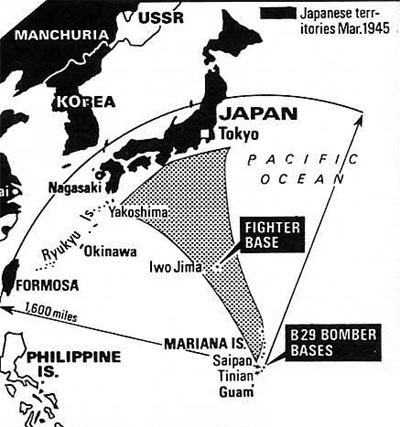
With the first operational flight of the newly introduced B-29 taking place on 24 April 1944 from a Chinese airfield, the complex and very advanced design of the all new Bomber came right in time after so many production delays. There were serious teething problems with the intricate Wright R-3350 Duplex Cyclone radial piston engines (cranking out together almost 9000 hp), the first prototypes had crashed with engine fires and that problem would remain a persistent threat throughout the war. It was mainly due to the personal engagement of General Hap Arnold with help from Charles Lindberg and Boeing‘s continued development as a private venture that the novel aircraft had made it to production status. Arnold later also intervened during the production of the first models, in order to have the endless list of modification applications to be speeded up and getting the aircraft soonest to the Pacific War theater. The earlier plan to also send the B-29 Bomber to Europe was soon skipped, as the long distance flight range of this aircraft was clearly more needed in the Pacific against the islands of Japan, which in the spring of 1944 were still at a respectable distance from US-held positions.
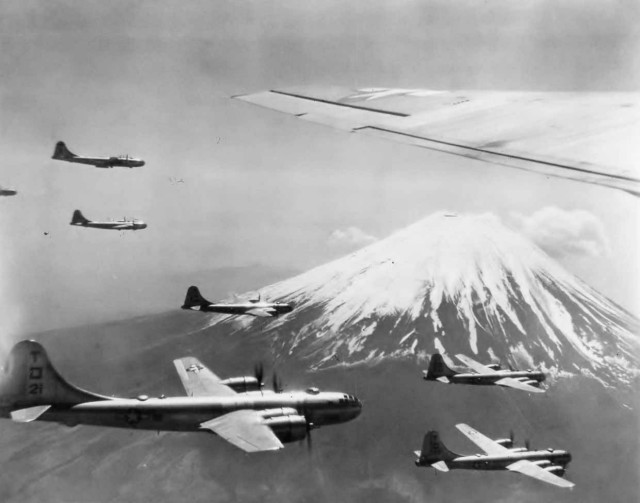
Photo above shows a fleet of B-29s flying over Mount Fuji, the Sacred Mountain for the Japanese, one of their National Symbols of Pride and Supremacy. The view of the intruders flying overhead by the masses became a daily sight since the end of November 1944. It must have provoked most humiliating sentiments for the Japanese Population that since 1942 was told by propaganda that Nippon’s Victory was imminent and soon the total Far East and Western Pacific would be settled under Imperial Rule, with Tojo’s promise of the “Greater East Asia Co-Prosperity Sphere”. But with more cities burning almost every day, that idealistic view soon melted down to a new reality. Japan was now forced into the defense and every day, more bombing flights followed from the Marianas. Tokyo, mainly built from timber houses was attacked again and again with incendiary carpet bombing that set fire to large parts of the densely populated Capital with over a million inhabitants. And even that was only the beginning of a true Armageddon to come like mankind had never seen before in its history.
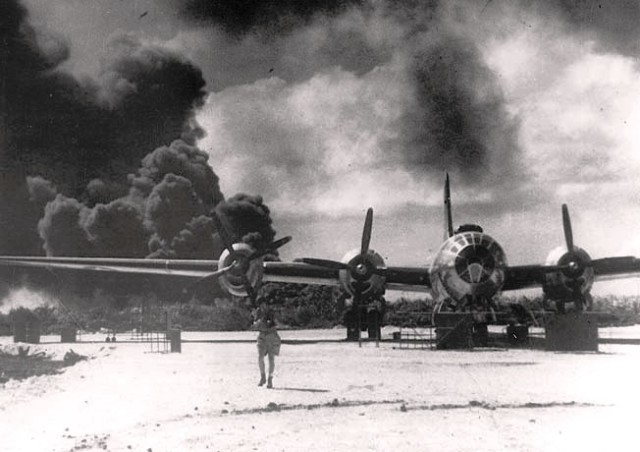
Photo above shows the burning oil storage tanks on Saipan after an air attack by Japanese bombers and fighters. In a desperate effort to turn the tide of the War and to stop the devastating Carpet Bombing flights over Japan, the Japanese did multiple frantic attacks on the Marianas in the hope to knock out those B-29s, the flying Giant Vultures that picked Japan’s flesh from its bones while still alive.
Between November 1944 and January 1945, the Japanese attacked the airfields with Bombers, that flew in from Japan but were staged from another tiny island still in Japanese hands, Iwo Jima. That island is located halfway between Japan and Guam (see map) in a very strategic position, as the Japanese had no long-distance bombers that could fly the 2x 1500 miles back and forth non-stop. Iwo Jima was the indispensable fuel / supply base for all of Japan’s Naval and Air Force attacks directed to the Marianas.
With the help of that advanced Station in the vast ocean, the Japs were able to attack and destructed 11 B-29s , while 45 were damaged. In the end, 45 American soldiers were killed and 200 wounded in the attacks. That could not stop the USAAF’s operations, while Japan lost 37 aircraft and faced an ever decreasing number of trained pilots and aircraft. But worse, the wrath of the USA would soon focus all of its fury and military power on that “little stone in the shoe”, aka Iwo Jima. Once that island conquered, the USA could be sure to have its hands free in the Marianas as no Japanese aircraft would be able to fly that distance non-stop from Japan. But in hindsight, the price that the USA paid to conquer that tiny island was monstrous and would finally influence their decision to take a very drastic shortcut to Nippon’s Surrender.
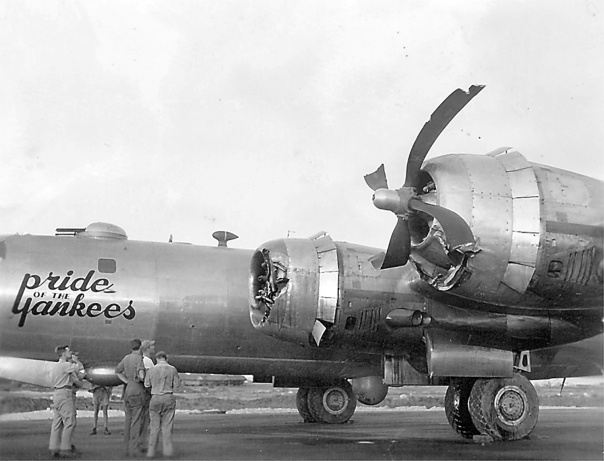
Photo above shows the near fatal damage to one of the B-29s returning from a bombing or harbor mining mission over Japan. With 2 engines knocked out by AA explosives, they lost a propeller while the outer engine was hit and switched off. It seems that they were very lucky as they had the chance to feather that damaged Prop, avoiding the windmilling and resulting heavy drag. That fortunate prop feathering during the flight back over a vast Ocean may have saved their day, their aircraft and the crew´s lives! Note the fabulous Name/ Nose Art of this ship, Pride of the Yankees and see how that logo is designed with those 2 letters coupled, love that stunning artwork! I will consider printing that logo name on a new T-shirt design: if interested , you please let me know...
Warning, graphic content, click to view
Photo above shows the dramatic end of Japanese Soldiers and Civilians who committed suicide by jumping from the cliffs of Saipan. Japanese propaganda had brainwashed them that surrender to the invading US troops was no option, as torture and rape would follow. Saipan and Tinian were pre-war occupied Japanese territory and the invasion took a high toll from both sides. The fierce resistance of the Japanese Military Forces only grew as the USA came closer to the Japanese Main Islands. The bloody battles to conquer Iwo Jima and Okinawa were the epitome of what the Japanese had in mind to ultimately defend their homeland, at any price.
The B-29 Superfortress was the first pressurized Bomber with 4 huge engines R-3350 Duplex-Cyclone and an advanced weapons and gunnery control system. With a crew of 11 and a length of 99 feet (30 m) and a wingspan of 140 feet (43 m), the B-29 was BIG by all means. You can imagine that with all that Hi -Tech equipment of those days, there were more than the average number of mechanics and technicians needed to keep the fleet of hundreds of B-29s operational. With a payload of over 20.000 kg, they could take an unparalleled number of bombs and fuel on their 1500 miles/ 2400 km flight to Tokyo . At a cruise speed of 220 mph (350 km/h) and a range of 3250 mi (5200 km) , the B-29 could cover most of the Japanese Islands. They were fast for that time (max speed 350 mph/ 575 km/h) and had a ceiling of 32000 feet (9700 m) which made them less vulnerable in the attacks of Japanese fighters. The Marianas and the B-29 , they were made for each other, a fantastic match that largely contributed to bring TheEmpire of the Sun on its knees.
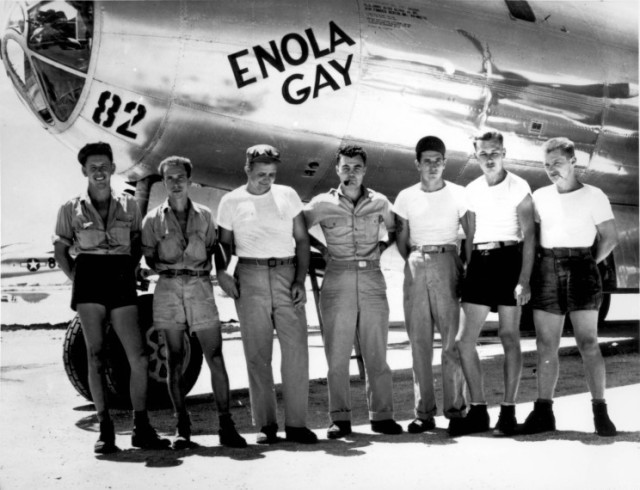
Photo above depicts the B-29 “Enola Gay” which atom-bombed Hiroshima from the Marianas. Col. Paul W.Tibbets, is in the center. On 6 August 1945, they launched the first Atomic Bomb in History, named Little Boy. This legendary B-29 is now on display in the Smithsonian Steven F. Udvar-Hazy Museum, outside Dulles Airport in Washington, D.C. A second Atomic Bomb (named Fat Boy) was launched 3 days later on Nagasaki, which made Japan surrender unconditionally on 15 August 1945. It was formally signed on 2 September 1945 on board USS Missouri in the Tokyo Bay.
In 1965, I flew from Holland to my parents, living as Shell expats in Yokohama, Japan. The flight was in a KLM DC-8 over the North Pole with one stop-over in Anchorage, Alaska. That was a magic experience, flying in summertime over the icecap in full sunlight. I came to live in Japan for 3 months and was stunned by the masses of people living jam-packed in the Yokohama- Tokyo Metropole. Going out to the Beach on a lazy Sunday afternoon became a deception. There were a million people having the same idea, on only a few square miles of a smothering Beach and swimming in the sea was totally impossible. Another million people were standing in the water, no joke, not even a space left for a refreshing dive. The seawater was luke warm, guess why?
But the dynamics of their economic growth were most astounding, it was the time that they were about to “reconquer” the World, 20 years after their defeat. Not with Military Power but with their Global Brands as Honda, Panasonic, JVC, Canon, Sony and many others. Japan was living in a “Frenzy of Fortune” with their successes in the mass-production of consumer goods that brought them a new wealth.
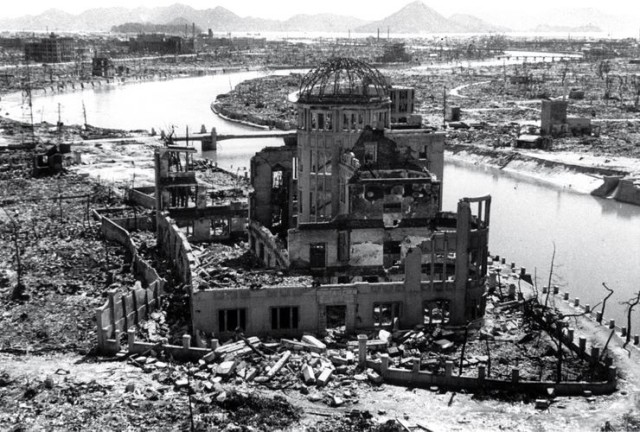
Photo above shows the Domed building, later the Peace Memorial of Hiroshima, just a few weeks after the first launch of the Atomic Bomb on 6 August 1945. The total devastation of the City is well visible, in miles around hardly any building left intact, only a few brick-built factories still standing. At that time that I was visiting the Museum Memorial, I was much impressed but there was never a public discussion about the justification of that attack.
It must have been a horrendous dilemma for the US President and his Staff, but even in hindsight, I honestly believe it was a righteous decision. The assault on the small island of Okinawa in 1945 had cost 90.000 soldiers and civilians their lives, of which 12.000 American soldiers. With this dazzling number of casualties on a small fortified island, the estimate was that an invasion of the Japanese Home Islands would cost probably over a million casualties.
The drop of the Atomic Bomb in all its bizarre comparisons and calculations seemed far from the worst scenario to bring this war to an end. An Allied invasion of the Islands as an alternative would surely result in a “prompt and utter destruction” of the Empire. For whatever reason, General Douglas MacArthur’s philosophy to “reset” Japan after the war, and retaining the position of Emperor Hirohito (a controversial decision at that time), that all worked wonder for that nation. The “Bomb” took its place in that shocking piece of history, named the Pacific War and Japan resurrected in an amazing pace.
I saw the scars of that war as a young kid living in Borneo between 1950-1957 and became “begeistert” by all the transports, devastated rigs and ships, aircraft wrecks and bunkers around me. I must have asked my Dad over and over again “…and what happened here?”. With such curious mindset for war history, some 10 years later, my father invited me to come with him to Hiroshima, where we visited that Peace Memorial. That domed building was once the epicenter of the first nuclear Bomb attack by the B-29 Enola Gay. I asked the Museum guide where that aircraft had started from in order to accomplish this dramatic flight. He said “The Marianas, those tiny islands out there in the Ocean that they had transformed into unsinkable aircraft carriers”. I had never heard of that name.
50 Year after that Hiroshima visit, I wrote a book about my lifetime experiences with War History, Vintage Aircraft etc. The book is titled The Dakota Hunter and describes my search of the legendary DC-3 on the last frontiers in this world: wrecked, abandoned, crashed or still flying. Engagingly written in 320 pages and with 250 unique photos of my expeditions to the Yukon, the High Andes, Venezuela, Honduras, Madagascar, Bolivia and the Colombian Amazon Jungle. I met the pilots, the local communities in remote places where the last of the WW II built aircraft still struggle for survival. They fly in the food, fuel and videos but also the more illicit trade as drugs and weapons for the Military and the War Lords. As I came flying in as an single “extranjero”, they all wanted to meet me, quite evidently, it’s the smell of money. Read about my encounters and dealings with them, those characters that could easily fit in an Indiana Jones movie script.
Come with me to see the wrecks and crashed aircraft that I visited for recovering the intact parts, and always with that indomitable curiosity and the questions that I ask since my youth years in Borneo “… and what happened here?”. It means diving into the history of the final and often fatal flight of the wrecks I ran into.
For ordering this book, you can go directly to the Amazon page by clicking here at Ordering at Amazon The Dakota Hunter Book. For 5-star reviews of my book The Dakota Hunter, scroll down on that Amazon page. For Previews and my earlier Dakota Hunter Blogs (also about that Yukon Crash), click here at dc3dakotahunter.com.
Read one of my most successful Blogs here about the PBY-5 Catalina that I flew as a young kid over the Jungle and rivers of Borneo. Click Dakota Hunter Catalina Photo Album. ( photo Yukon crashed C-47 courtesy, Felix Stadler)
Enjoy, Hans Wiesman, author of The Dakota Hunter
